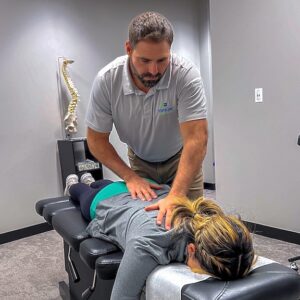If you’ve ever experienced the sharp, stabbing pain of plantar fasciitis, you know how debilitating it can be. This common foot condition can make simple tasks like walking a real challenge. While many people turn to orthopedic specialists or physical therapists for help, you might be surprised to learn that chiropractors can also provide effective treatment for plantar fasciitis. In this article, we will explore the world of chiropractic services and how a chiropractor can help you find relief from this painful condition.
What is Plantar Fasciitis?
Before we dive into chiropractic treatment, let’s understand what plantar fasciitis is. The plantar fascia is a thick band of tissue that runs along the bottom of your foot, connecting the heel bone to the toes. This tissue supports the arch of your foot and plays a crucial role in walking and other weight-bearing activities. Plantar fasciitis occurs when this tissue becomes inflamed and irritated, leading to intense pain in the heel or arch of the foot.
Chiropractic Services and Plantar Fasciitis
Chiropractors are well-known for their expertise in spinal adjustments, but they are also trained in treating various musculoskeletal conditions, including those that affect the feet. When it comes to plantar fasciitis, chiropractic services offer a non-invasive, drug-free, and holistic approach to pain relief. Let’s explore some of the chiropractic methods commonly used to treat this condition.
Spinal Adjustments: While it may seem counterintuitive, spinal adjustments can play a role in addressing plantar fasciitis. A chiropractor will examine your spine to ensure proper alignment, as misalignments in the spine can affect the way you walk and distribute weight on your feet. By correcting these misalignments, the stress on your feet can be reduced, potentially alleviating plantar fasciitis symptoms.
Foot and Ankle Adjustments: Chiropractors are skilled in adjusting various joints throughout the body, including those in the feet and ankles. By manipulating these joints, they can help improve range of motion, reduce inflammation, and relieve tension in the plantar fascia.
Soft Tissue Techniques: Chiropractors often use soft tissue techniques such as massage, myofascial release, and stretching to relieve tension in the muscles and connective tissues around the foot. These techniques can help reduce pain and improve flexibility in the affected area.
Custom Orthotics: Chiropractors can create custom orthotic inserts for your shoes to provide better arch support and reduce pressure on the plantar fascia. These orthotics are designed to fit your specific foot shape and walking patterns, which can make a significant difference in your comfort and recovery.
Strengthening Exercises: Chiropractors may recommend specific exercises to strengthen the muscles in your feet and lower legs. Stronger muscles can provide better support to the plantar fascia and help prevent future flare-ups of plantar fasciitis.
What to Expect During a Chiropractic Visit
When you’re considering a visit to a chiropractor, knowing what to expect during your appointment can alleviate any concerns or uncertainties you might have. Chiropractic visits are typically divided into several key phases, each serving a specific purpose to help the chiropractor understand your condition and develop an appropriate treatment plan.
1. Initial Consultation and Health History
The first step of your chiropractic visit involves an initial consultation where you will have a conversation with the chiropractor. They will discuss your health history, including any past injuries, surgeries, medical conditions, lifestyle factors, and your current symptoms. It’s essential to be thorough and accurate in providing this information, as it helps the chiropractor assess your overall health and understand the context of your visit.
2. Physical Examination
Following the initial consultation, a comprehensive physical examination is conducted. The chiropractor will assess your posture, spinal alignment, muscle tone, and joint mobility. They may perform various orthopedic and neurological tests to evaluate your muscle strength, reflexes, and range of motion. This examination allows the chiropractor to pinpoint areas of concern and potential misalignments in your spine or other parts of your body.
3. Diagnostic Tests (if needed)
Depending on your specific case, the chiropractor may order diagnostic tests like X-rays, MRI scans, or other imaging studies to get a more detailed view of your musculoskeletal structure. These tests provide crucial insights into the condition of your spine and help in formulating a precise diagnosis.
4. Assessment and Diagnosis
Based on the gathered information from your health history, physical examination, and any diagnostic tests, the chiropractor will formulate a diagnosis. They will explain their findings to you, discuss the identified issues, and outline a tailored treatment plan to address your concerns. This plan will often include the proposed chiropractic adjustments and other complementary treatments.
5. Chiropractic Adjustments
Chiropractic adjustments, also known as spinal or manual manipulations, are a hallmark of chiropractic care. During these adjustments, the chiropractor uses their hands or specialized instruments to apply controlled, sudden force to specific joints in your spine or other parts of the body. The goal is to correct misalignments (subluxations) and restore proper alignment, mobility, and function.
The adjustments are generally safe and performed with precision to alleviate pain, improve range of motion, and facilitate the body’s natural healing processes. You might hear a cracking or popping sound during an adjustment, which is normal and caused by the release of gas bubbles from the joints.
6. Additional Therapies and Recommendations
In addition to chiropractic adjustments, your treatment plan may include complementary therapies such as
Soft Tissue Techniques: Massage, myofascial release, or trigger point therapy to relieve muscle tension and improve flexibility.
Stretching and Strengthening Exercises: Specific exercises to enhance the strength and flexibility of targeted muscles and joints.
Heat or Cold Therapy: Application of heat or cold packs to reduce inflammation and promote healing.
Custom Orthotics: If needed, the chiropractor may recommend custom shoe inserts to provide better support and alignment for your feet.
Your chiropractor will also provide recommendations for lifestyle changes, posture improvements, ergonomic adjustments, and nutritional advice to complement the in-office treatments and support your overall well-being.
7. Follow-Up Visits and Progress Evaluation
After your initial chiropractic visit, you will typically schedule follow-up appointments to track your progress and make any necessary adjustments to your treatment plan. During these visits, the chiropractor will assess your response to the treatments, perform any needed adjustments, and modify your exercises or therapies based on how you’re progressing.
Benefits of Chiropractic Treatment for Plantar Fasciitis
There are several advantages to choosing chiropractic services for the treatment of plantar fasciitis:
Holistic Approach to Healing:
Chiropractic treatment takes a holistic approach to healing, considering the body as a whole system. Chiropractors do not just focus on treating the symptoms of plantar fasciitis, but they assess the entire musculoskeletal structure, including the spine, legs, and feet. By understanding how different parts of the body interact, chiropractors can identify and address the root causes of plantar fasciitis, leading to more effective and lasting relief.
Non-Invasive and Drug-Free Pain Relief:
One of the significant benefits of chiropractic treatment is that it offers non-invasive and drug-free pain relief. Many individuals prefer this approach, as it avoids the risks and potential side effects associated with medications or surgery. Chiropractors use manual techniques, adjustments, and therapies to alleviate pain and promote natural healing without relying on pharmaceuticals or invasive procedures.
Customized Treatment Plans:
Chiropractic care is highly individualized. Chiropractors tailor treatment plans to suit each patient’s unique needs and condition. For plantar fasciitis, the treatment plan is specifically designed based on factors such as the severity of the condition, the patient’s overall health, lifestyle, and preferences. This customized approach ensures that the treatment addresses the specific issues contributing to the plantar fasciitis in each patient.
Improvement in Foot Functionality and Mobility:
Chiropractors use various techniques to enhance foot functionality and mobility. Adjustments to the feet, ankles, and lower extremities can help restore proper alignment and movement. By aligning the bones and joints, chiropractic treatment can reduce stiffness, improve flexibility, and optimize the biomechanics of the feet. This leads to enhanced mobility, making it easier for individuals to perform daily activities without the limitations imposed by plantar fasciitis.
Alleviation of Inflammation and Tension:
Plantar fasciitis is often accompanied by inflammation and tension in the plantar fascia, which is the thick band of tissue connecting the heel to the toes. Chiropractic techniques such as soft tissue manipulation, massage, and stretching can effectively target and reduce inflammation and tension in the affected area. By alleviating these factors, chiropractic treatment helps to relieve pain and discomfort associated with plantar fasciitis.
Preventative Measures and Education:
Chiropractors not only focus on immediate pain relief but also emphasize long-term well-being. They educate patients on proper foot care, footwear choices, exercises, and lifestyle modifications that can help prevent the recurrence of plantar fasciitis or other foot-related issues. By empowering patients with knowledge and preventive strategies, chiropractic care promotes a proactive approach to foot health and overall wellness.
Avoidance of Surgical Intervention:
In many cases, chiropractic care can help individuals avoid the need for surgical intervention. By addressing misalignments, reducing inflammation, and promoting healing, chiropractic treatment offers a conservative and effective alternative to surgery. This is particularly beneficial for those who prefer non-surgical options or want to explore less invasive treatments before considering more aggressive measures.
Enhanced Overall Well-being:
Chiropractic treatment not only targets the specific ailment but also aims to improve the overall well-being of the patient. By optimizing spinal and musculoskeletal health, chiropractors contribute to better posture, improved nervous system function, and enhanced energy levels. Patients often report an overall improvement in their quality of life, which extends beyond the alleviation of plantar fasciitis symptoms.
Is Chiropractic Treatment Right for You?
Chiropractic care can be an excellent option for many individuals dealing with plantar fasciitis. However, it’s essential to consider your specific circumstances and consult with a qualified chiropractor to determine if this approach is suitable for you.
Here are some factors to consider when deciding if chiropractic treatment is the right choice:
Severity of Your Condition: The severity of your plantar fasciitis can impact the effectiveness of chiropractic treatment. Chiropractic care is often most beneficial for mild to moderate cases.
Overall Health: Your general health and any other underlying conditions may affect your eligibility for chiropractic care. Discuss your medical history with the chiropractor during your consultation.
Personal Preferences: Some individuals prefer non-invasive, drug-free treatments, while others may be more open to medications or surgical options.
Commitment to Home Care: Chiropractic treatment often involves exercises and stretches you will need to do at home. Consider whether you’re willing and able to commit to this aspect of the treatment plan.
Consultation with a Chiropractor: The best way to determine if chiropractic treatment is right for you is to schedule a consultation with a chiropractor near me who can assess your condition and provide personalized recommendations.
In conclusion, chiropractic care extends far beyond simply addressing back pain, showcasing a diverse array of benefits for overall well-being. From alleviating headaches to enhancing mobility and posture, chiropractic services offer a holistic approach to health. By focusing on spinal health and alignment, chiropractors aim to optimize the nervous system, promoting the body’s innate ability to heal itself. Patients can experience improved function, reduced pain, and an enhanced quality of life through regular chiropractic treatments. Embracing chiropractic care means embracing a proactive approach to health, acknowledging the interconnectedness of the body’s systems and empowering individuals to live their lives to the fullest.
Why Choose UsEvolve Chiropractic of Downers Grove?
Evolve Chiropractic of Downers Grove is a leading chiropractic center that prides itself on being the top choice for individuals seeking exceptional chiropractic care in the Downers Grove area. Our clinic is dedicated to providing personalized, high-quality chiropractic services tailored to meet the unique needs of each patient.
At Evolve Chiropractic of Downers Grove, we prioritize the overall well-being and health of our patients. Our skilled and experienced team of chiropractors utilizes advanced techniques and state-of-the-art equipment to address a wide range of musculoskeletal issues, including back pain, neck pain, joint discomfort, headaches, and more.
With a commitment to excellence, compassionate care, and a patient-centric approach, Evolve Chiropractic of Downers Grove stands out as the preferred choice for individuals seeking the best chiropractic care in the vicinity. We invite you to experience the difference and embark on a journey towards a healthier, more vibrant life with us.
Evolve Chiropractic of Downers Grove
2946 Finley Rd, Downers Grove, IL 60515, United States
630-613-9248





